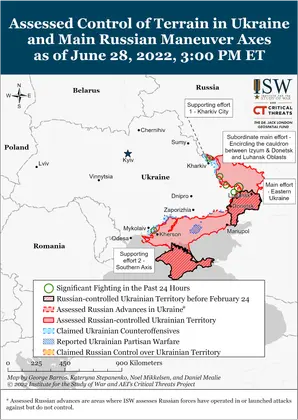Key Takeaways
- Russian forces continued to launch assault operations south and southwest of Lysychansk. The Luhansk People’s Republic (LNR) officials claimed that Ukrainian forces had begun to withdraw from the city, but ISW cannot confirm these claims.
- Russian forces launched unsuccessful offensive operations north of Slovyansk and conducted spoiling attacks on settlements west of Izyum, likely to disrupt Ukrainian counteroffensives.
- Russian forces failed to advance along the Kharkiv City-Belgorod highway and continued to undertake measures to hinder Ukrainian advances towards the international border or Izyum.
- Ukrainian forces continued to launch counteroffensives north of Kherson City and reportedly liberated two settlements.
- Russian forces continued to transfer military equipment and personnel east of Melitopol.
- Russian occupation authorities are maintaining unsuccessful efforts to introduce ruble salary payments and set conditions to inflate electoral numbers in a future referendum.
Ukrainian forces are likely conducting a fighting withdrawal that may include pulling back from Lysychansk and Luhansk Oblast in the near future and which probably aims to force the Russian offensive to culminate prematurely.
JOIN US ON TELEGRAM
Follow our coverage of the war on the @Kyivpost_official.
The Luhansk People’s Republic (LNR) Ambassador to Russia Rodion Miroshnik and Russian milbloggers claimed that Ukrainian forces began a large-scale withdrawal from Lysychansk towards Siversk, Kramatorsk, and Slovyansk on June 28. Although ISW cannot confirm independently Miroshnik’s claims of an ongoing withdrawal, Ukrainian forces may continue the fighting withdrawal that began in Severodonetsk to Ukrainian strongholds around Siversk, Kramatorsk, and Slovyansk. The staunch but limited Ukrainian defense of Severodonetsk imposed high costs on the Russians despite new Russian tactics intended to limit Russian casualties. Kyiv could continue this approach until the Russian attack culminates or Ukrainian forces reach more defensible positions along a straighter line dotted with fortified cities and towns.
The pace and outcome of the next phase of the current campaign may depend in part on Russia’s ability to recoup combat power from the forces that participated in the Battle of Severodonetsk.
The remaining Russian forces in Severodonetsk will need to cross the Siverskyi Donets River into Lysychansk from Severodonetsk or its surrounding settlements to participate further in the Russian offensive. This movement could require some time since the Russians destroyed the three main bridges across the river near the city. Miroshnik claimed that Russian forces have already crossed the Siverskyi Donets River from Kreminna and are building bridgeheads for further attacks on Lysychansk from the north. ISW cannot independently verify Miroshnik’s claims. If they are true, and Russian forces threaten to complete the cauldron by pushing from the north and southwest of Lysychansk, then Ukrainian forces will likely abandon Lysychansk as well and conduct a fighting withdrawal to more defensible positions. Russian forces that have engaged in continuous offensive operations in Severodonetsk will also require some time to restore combat capabilities before participating in an assault on northern or northeastern Lysychansk. An unnamed Pentagon official stated that Russian forces continue to endure significant losses in fights for small territorial gains, and Russian groups that fought in Severodonetsk likely lost personnel and equipment. The locations and strength of the Russian troops that seized Severodonetsk remain unclear at this time, however. A notable acceleration of Russian attacks from the south of Lysychansk or from across the Siverskyi Donetsk River would likely indicate that the Russians have completed a redeployment of forces from Severodonetsk. ISW has not yet observed such indicators.

Holiday Spirit Thrives Among Ukrainians Despite War, Study Finds
Ukraine’s Conflict Intelligence Team (CIT) reported that the Kremlin replaced Western Military District (WMD) Commander Alexander Zhuravlev with the former commander of the 8th Combined Arms Army (CAA) Andrey Sychevoy.
CIT added that WMD Chief of Staff Aleksey Zavizion was relieved. ISW cannot independently verify these reports and will continue to monitor the situation for further corroboration.
Russian forces continue to look for additional reserves to replenish personnel losses in Ukraine, but these reserves are unlikely to initiate rotations or provide combat-ready manpower.
Chechen leader Ramzan Kadyrov announced that he will form four new battalions “with an impressive number of personnel” on June 26. Kadyrov also announced that Chechen forces formed a West-Akhmat battalion “in the shortest possible” time and claimed that the unit would deploy to a well-equipped base in Chechnya. Chechen forces will likely deploy the newly-created battalion to the frontline without sufficient training. Social media users also released footage of the Donetsk People’s Republic (DNR) rounding up “volunteers” in Donetsk City as part of the recruitment campaign on June 28. Wives of servicemen of the Russian 5th Guards Separate Tank Brigade issued a video plea for the immediate rotation of their husbands back home, noting that their husbands had left their permanent bases of deployment in January 2022 for “exercises in Belarus.” The video indicates that the Russian military command has expressed its intentions for unit rotations.
Authors: Kateryna Stepanenko, Frederick W. Kagan, George Barros, Mason Clark, and Grace Mappes
Read the full report here.
You can also highlight the text and press Ctrl + Enter






